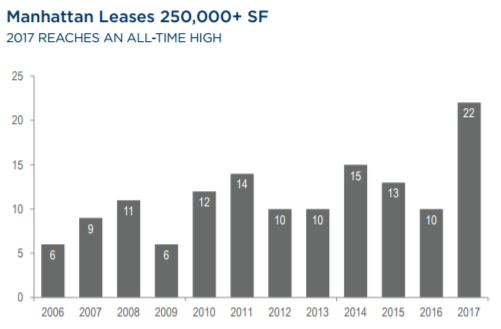New Manhattan Office Product to Soar in 2018
Coming off strong leasing activity in 2017, the Manhattan office sector is set to welcome this year its highest amount of new office product since 1986, Cushman & Wakefield executives noted at the firm's latest press briefing on the market.
By Samantha Goldberg
The Manhattan office market had a strong performance in 2017, with leasing reaching its second-highest level in 17 years. This year is set to be no different, as a wave of new product is poised to hit the market, according to Cushman & Wakefield’s Jan. 10 press briefing on the Manhattan office market.
Manhattan office leasing in 2017 outperformed the previous year’s activity by 16 percent, with 30.5 million square feet of new leases and 9 million square feet of renewals transacted, the firm’s fourth-quarter Manhattan office report shows. The activity was fueled by large corporations continuing to take up space, with 27 new leases exceeding 100,000 square feet signed in the fourth quarter and 22 leases greater than 250,000 square feet signed in full-year 2017. Some notable office leases were Ernst & Young taking up 675,062 square feet at One Manhattan West for its new corporate headquarters and Bank of America occupying 343,026 square feet at 1100 Avenue of the Americas, expanding its New York headquarters.
“2017 was a year of big deals,” noted Lou D’Avanzo, vice chairman & managing principal in Cushman & Wakefield’s Manhattan office. “Large corporations continue to believe in New York City and are committing people and resources here long term.”
The sectors fueling office leasing activity in Manhattan continue to be the financial services and TAMI sectors. While total employment in the market in 2017 had its ups and downs, the financial services sector in particular had a strong year, creating 12,700 jobs through November and hitting employment levels not seen in 17 years. While TAMI sector employment was a bit softer, losing 9,000 jobs through November, Cushman & Wakefield Principal Economist Ken McCarthy noted that many of the jobs being created in the financial services sector are actually TAMI-related jobs. He pointed as an example to JP Morgan, which last year tripled its space in 5 Manhattan West for its digital teams.
Supply Surge
Despite strong leasing activity in Manhattan, the Cushman & Wakefield presenters noted that the city’s office supply needs to be upgraded in order to retain and attract new companies (The average age of existing office product is 84 years old, pointed out Richard Persichetti, regional director of research at Cushman & Wakefield.)
“New construction for an aging office stock is definitely a good thing for the city,” he added.
Real estate developers and investors seem to be taking note, as more than 5.7 million square feet of new construction is slated for delivery in 2018, marking the highest amount of office product to come online since 1986. The firm also forecasts that 22.1 million square feet of new office development is expected to come online between 2018 and 2022.
Despite an increase of 1.5 million square feet of sublease space since the end of 2016, strong leasing activity and a decline in direct available space pushed Manhattan’s overall vacancy down by 40 basis points year-over-year to 8.9 percent in the fourth quarter, the first time in six quarters that vacancy fell below 9 percent. However, new construction is likely to push vacancy rates somewhat higher.
Ahead of these new product deliveries, landlords have been actively marketing and pursuing tenants, D’Avanzo noted, as seen in the increase in corporations signing lease commitments well in advance of their lease expirations in order to secure a spot in the upcoming developments. As expected, this is having a negative impact on net effective rents for existing Class A office space, with fourth-quarter asking rents in Manhattan declining 0.9 percent in Midtown, 2.8 percent in Midtown South and 0.3 percent in Downtown.
To compete, landlords of existing Class A space are upgrading their spaces and trying to persuade current tenants to renew their leases early, with concessions now at historic highs.
“There’s been a lot of reinvestment by Midtown landlords to make sure their space is competitive,” D’Avanzo noted. “There’s always a flight to quality, but fortunately that new space that is coming online over the next five years is not all coming online at once. Midtown still highly desirable place to be. The landlords are a pretty smart group with a lot of capital and they aren’t going to let their assets not keep pace. “









You must be logged in to post a comment.